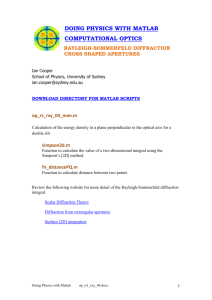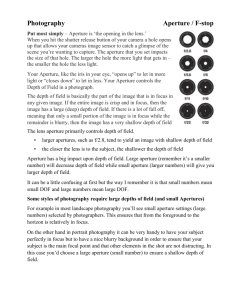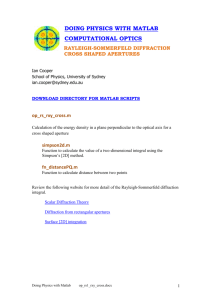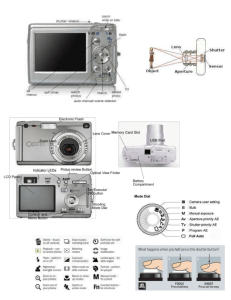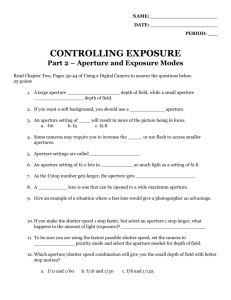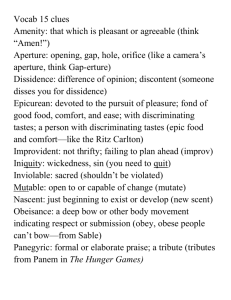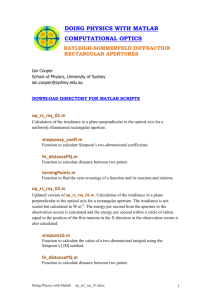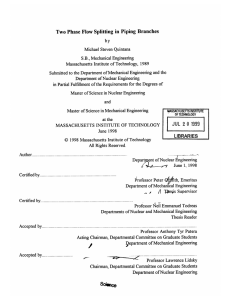Diffraction, Numerical Integration
advertisement
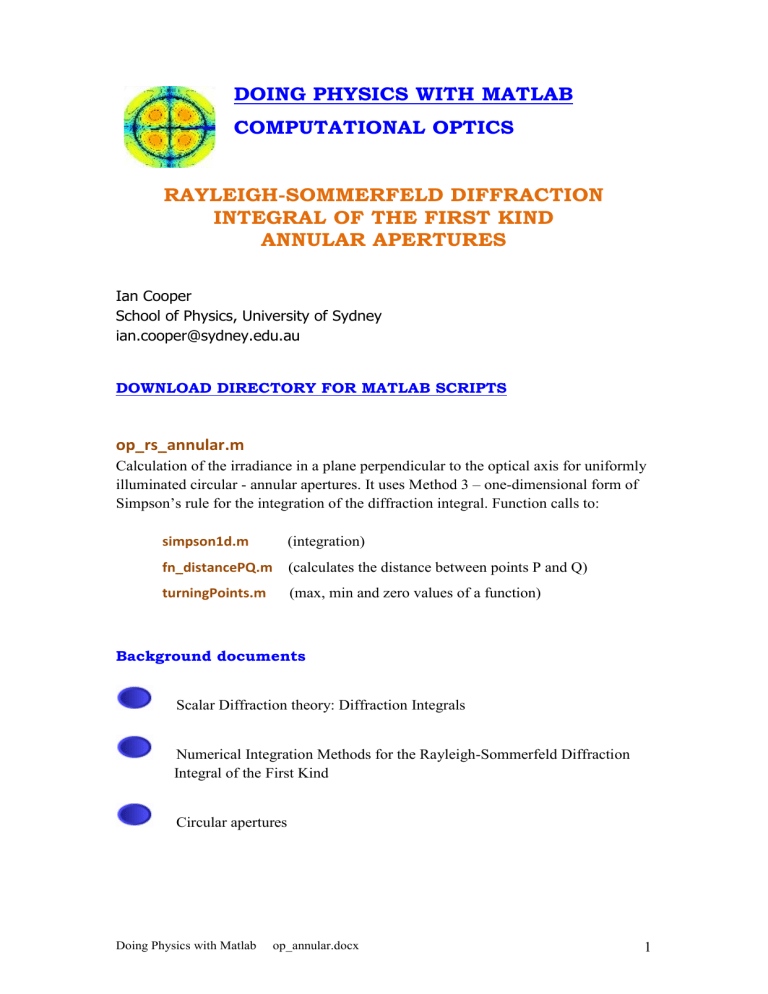
DOING PHYSICS WITH MATLAB COMPUTATIONAL OPTICS RAYLEIGH-SOMMERFELD DIFFRACTION INTEGRAL OF THE FIRST KIND ANNULAR APERTURES Ian Cooper School of Physics, University of Sydney ian.cooper@sydney.edu.au DOWNLOAD DIRECTORY FOR MATLAB SCRIPTS op_rs_annular.m Calculation of the irradiance in a plane perpendicular to the optical axis for uniformly illuminated circular - annular apertures. It uses Method 3 – one-dimensional form of Simpson’s rule for the integration of the diffraction integral. Function calls to: simpson1d.m (integration) fn_distancePQ.m (calculates the distance between points P and Q) turningPoints.m (max, min and zero values of a function) Background documents Scalar Diffraction theory: Diffraction Integrals Numerical Integration Methods for the Rayleigh-Sommerfeld Diffraction Integral of the First Kind Circular apertures Doing Physics with Matlab op_annular.docx 1 RAYLEIGH-SOMMERFELD DIFFRACTION INTEGRAL OF THE FIRST KIND UNIFORMLY ILLUMINATED ANNULAR APERTURES The Rayleigh-Sommerfeld diffraction integral of the first kind states that the electric field at an observation point P can be expressed as E (P) (1) 1 2 E (r ) SA e jkr r3 z p ( jkr 1) dS It is assumed that the Rayleigh-Sommerfeld diffraction integral of the first kind is valid throughout the space in front of the aperture, right down to the aperture itself. There are no limitations on the maximum size of either the aperture or observation region, relative to the observation distance, because no approximations have been made. The irradiance or more generally the term intensity has S.I. units of W.m-2. Another way of thinking about the irradiance is to use the term energy density as an alternative. The use of the letter I can be misleading, therefore, we will often use the symbol u to represent the irradiance or energy density. The irradiance or energy density u of a monochromatic light wave in matter is given in terms of its electric field E by (2) u c n 0 2 E 2 where n is the refractive index of the medium, c is the speed of light in vacuum and 0 is the permittivity of free space. This formula assumes that the magnetic susceptibility is negligible, i.e. r 1 where r is the magnetic permeability of the light transmitting media. This assumption is typically valid in transparent media in the optical frequency range. The integration can be done accurately using any of the numerical procedures based upon Simpson’s rule to compute the energy density in the whole space in front of the aperture. Numerical Integration Methods for the Rayleigh-Sommerfeld Diffraction Integral of the First Kind Doing Physics with Matlab op_annular.docx 2 The geometry for the diffraction pattern from circular type apertures is shown in figure (1). radial optical coordinate centre of circular aperture origin (0,0,0) x P(xP,yP,zP) vP 2 a sin z: optical axis aperture plan z=0 y xP y P 2 sin 2 observation plan z = zP xP 2 y P 2 z P 2 Fig. 1. Circular aperture geometry. The radial optical coordinate vP is a scaled perpendicular distance from the optical axis. (3) vP 2 a sin sin xP 2 y P 2 xP 2 y P 2 z P 2 Numerical integration of the Rayleigh-Sommerfeld diffraction integral of the first kind given by equation (1) for annular apertures can be done using a one-dimensional form of Simpson’s rule (Method 3). The aperture space is partitioned into a series of rings and values of the electric field EQ are set either to zero or EQmax for each ring as shown in figure (2) Fig. 2. An annular aperture. The radius of the aperture is a and the 0 f 1. radius of the opaque disk is a1 where a1 f a Doing Physics with Matlab op_annular.docx 3 Consider the diffraction from an aperture with the following default parameters: Wavelength = 6.32810-7 m Aperture space grid points nQ = 360800 Observation space grid points nP = 509 Aperture Space radius of aperture a = 1.00010-4 m Energy density uQmax = 1.00010-3 W.m-2 Energy from aperture UQ(theory) = 2.35610-11 J.s-1 Observation Space Max radius rP = 2.00010-2 m Distance aperture to observation plane zP = 1.000 m Rayleigh distance dRL = 6.32110-2 m Energy: aperture to screen UP = 2.21410-11 J.s-1 Tables 1 and 2 give a summary of the optical coordinates vP for the dark rings, the percentage of the energy that is radiated from the aperture that is enclosed by the first dark ring on the observation screen, and the relative strengths of the peaks in the diffraction pattern. The figures show the diffraction pattern for the annular apertures modelled in Tables 1 and 2. Table 1. Optical coordinate vP for the dark rings and percentage of the energy enclosed within the first dark ring f 0 0.20 0.40 0.60 0.80 0.98 3.83 3.68 3.32 2.97 2.66 2.42 1st 7.00 7.34 7.50 6.80 6.10 5.59 2nd 13.33 9.69 10.36 10.63 9.58 8.72 3rd 16.46 13.72 12.67 14.19 13.06 11.92 4th 84 77 59 37 17 1.6 % energy Table 2. Optical coordinate vP for the peaks and their relative strengths f 0 0.20 0.40 0.60 0.80 5.12 5.12 4.97 4.65 4.22 1st 0.0175 0.0303 0.0706 0.1202 0.1527 8.40 8.44 8.68 8.44 7.740 2nd 0.0042 0.0015 0.0033 0.0305 0.0734 11.61 11.53 11.49 12.08 11.22 3rd 0.0016 0.00376 0.0007 0.0044 0.0401 14.78 14.89 14.62 15.05 14.70 4th 0.0008 0.0004 0.0028 0.0001 0.0109 Doing Physics with Matlab op_annular.docx 0.98 3.87 0.1621 7.08 0.0899 10.28 0.0621 13.45 0.0474 4 f =0 full circular aperture Doing Physics with Matlab op_annular.docx 5 f = 0.20 Doing Physics with Matlab op_annular.docx 6 f = 0.40 Doing Physics with Matlab op_annular.docx 7 f = 0.60 Doing Physics with Matlab op_annular.docx 8 f = 0.80 Doing Physics with Matlab op_annular.docx 9 f = 0.98 As the radius of the opaque disk increases from 0 to 1: The size of the Airy Disk decreases. Reduction in the percentage of the energy within the Airy Disk decreases. The relative strengths of the peaks do not necessarily decrease. Uneven spacing between minima and maxima. Doing Physics with Matlab op_annular.docx 10 Double annular aperture Doing Physics with Matlab op_annular.docx 11

